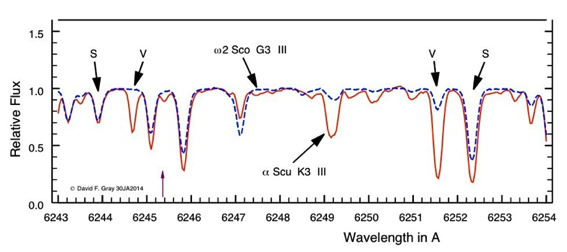Precision Stellar Temperatures
While there are many ways to determine stellar temperatures (see Photospheres, Chapter 14), here we consider only temperatures determined from the depths of spectral lines, specifically, ratios of the depths of temperature-sensitive lines to those that are almost insensitive to temperature. Typically vanadium lines having low excitation potentials are sensitive to temperature, while iron or nickel or titanium lines have a much lower sensitivity. Of course, all lines are temperature sensitive to some degree, so it is a matter of how much.
Consider the spectra in the following figure. These two stars differ by roughly 1000 K. Look at the marked pairs of lines. These are examples of good lines to use in line-depth ratios (‘S’ means stable, ‘V’ means variable). As you can see, the lines are weaker in the hotter star, but the 'V' lines change more than the 'S' lines.
Assuming one has a good spectrograph and can measure with high signal-to-noise ratio, it is possible to discern temperature variations ~ 1º K. Calibration is done by observing the chosen line-depth ratios for a set of stars with known temperatures. A study of the Sun, for example, indicates changes ~ 1.5 º K may occur over the solar magnetic cycle (see Gray & Livingston 1996 ApJ 474, 798 and ApJ 474, 802.
